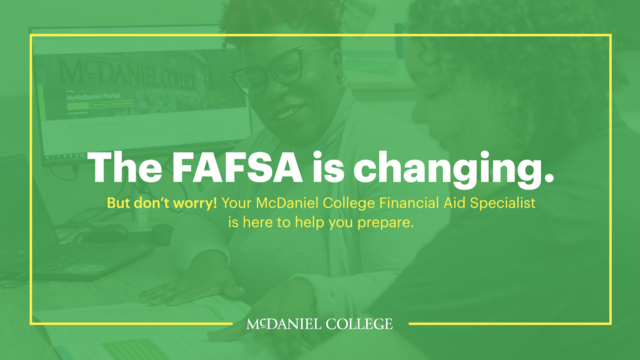McDaniel College Financial Aid provides important information about the new FAFSA
A new version of the Free Application for Federal Student Aid, known as the FAFSA, has been released by the Department of Education. Director of Financial Aid Kemia Himon answers questions about the new FAFSA.

The most important basic step for all students who wish to apply for financial aid is to submit the FAFSA (Free Application for Federal Student Aid) online. McDaniel’s school code is 002109 and must be added to your FAFSA for us to receive it.
A new version of the Free Application for Federal Student Aid, known as the FAFSA, has been released by the Department of Education. The new form comprises changes approved by Congress in 2020 through the FAFSA Simplification Act and is the first massive revamp in more than 40 years. The new form is shorter and easier to fill out, reducing barriers for certain student populations.

Kemia Himon
Director of Financial Aid Kemia Himon, who oversees the college's financial aid program of federal, state, and institutional aid, answers questions about the new FAFSA. Himon joined McDaniel College in 2020.
She has recently been interviewed by a number of Baltimore area media outlets about the new FAFSA.
More than 90 percent of students at McDaniel receive some type of financial assistance, and the college invests more than $50 million annually in need-based grants and merit scholarships to ensure that students from all kinds of financial backgrounds are able to experience a McDaniel education.
Questions about the new FAFSA
What is the FAFSA? The FAFSA, or Free Application for Federal Student Aid, is required for students to receive federal and state aid, as well as institutional need-based financial grants and scholarships (separate from any merit scholarships). The FAFSA is essential to gain access to grants, federal student loans and work-study programs. It is free to fill out.
Why was the Dec. 31 release of the new form such a big deal? Typically, the FAFSA is available starting Oct. 1, so the new form has caused a delay this year for students and families to receive their financial aid awards. Colleges also are not currently able to access FAFSA data—the Department of Education is expecting this information to be available at the end of January—providing even less time for colleges to be able to award financial aid packages and shortening the college-decision making timeframe for families.
What is the deadline to complete the FAFSA? The priority deadline to complete the FAFSA in order to receive state aid in Maryland is March 1, which is also our priority deadline at McDaniel, as it allows sufficient time for student financial aid awards to be processed. That said, the sooner the student files, the better, as some aid is awarded on a first-come, first-served basis.
What is required to fill out the FAFSA? First, students need to sign up for a Federal Student Aid ID in order to complete the FAFSA. Students and parents are each required to have their own IDs and can create these IDs even before filing the form.
It is also important to note that the FAFSA uses prior-prior tax returns, or tax information from two years ago. So, for the 2024-25 FAFSA award cycle, the tax information, which includes the student and parents tax returns, W-2 forms, etc., requested is from tax year 2022.
Why is the new form beneficial? The new form is designed to streamline and simplify the FAFSA filing process. While the actual number of questions on the FAFSA will vary by applicant based on their financial circumstance, most applicants will have to answer as few as 18 questions, which should take less than 10 minutes to complete. The previous form had over 100 questions. Also, some information will now be taken directly from a filer’s tax return and will no longer be able to be entered manually.
More students are also expected to qualify for a Pell Grant due to changes to the FAFSA calculation. All students enrolled for at least one credit hour will receive consideration for a Pell Grant and students will now be considered for one of three types of Pell Grants: maximum, minimum, or a calculated Pell amount. Eligibility is based on dependency status, family size, parent’s marital status, and the family’s adjusted gross income and how it compares with the federal poverty guideline.
What else is new on the FAFSA form? The Student Aid Index (SAI) has replaced Expected Family Contribution (EFC) as an estimate of the student’s ability to pay for college, generated based on information provided on the FAFSA. It is not necessarily equal to what a student will pay to enroll in college.
The new FAFSA calculates the SAI slightly differently than the EFC. It removes the number of family members in college from the calculation and farms and small businesses are now required to be reported. For parents who are divorced or separated, the form now requires financial information from the parent who provided the most financial support to the student.
The new form also allows students to list up to 20 schools to receive their FAFSA information. Previously, the limit was 10 schools.
Why is it important for students to complete the FAFSA? Each year, there are millions of students who would have qualified for college grants that fail to file the FAFSA. Students not only receive federal aid by filing the FAFSA, but can also get state aid, as well as institutional need-based financial grants and scholarships. It is also important to remember that the FAFSA needs to be filled out each year.